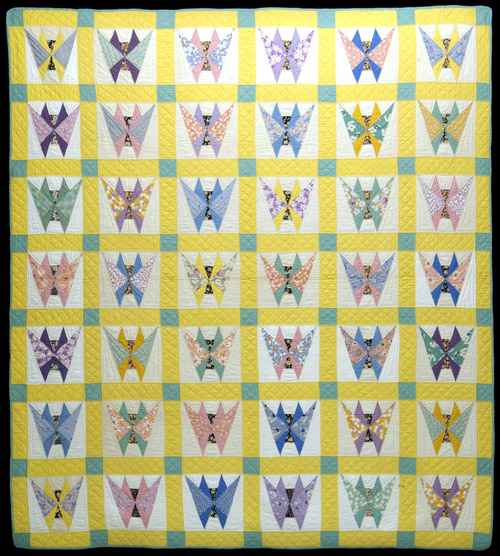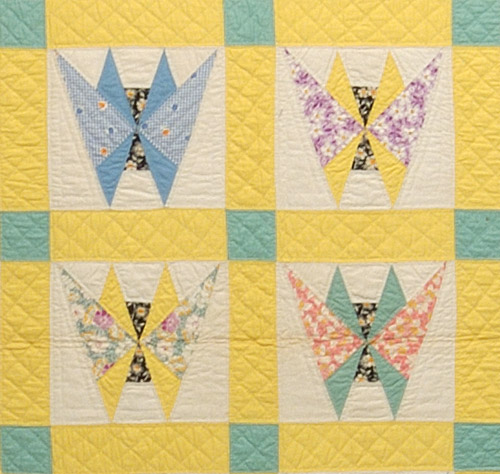
QUILT INDEX RECORD
12-8-5166
Who documented this quilt?
Michigan Quilt Project; Michigan State University Museum Collection
Where are the records for this quilt housed?
Michigan State University Museum
Michigan Quilt Project Number:
94.0096
If this quilt is owned by a museum, enter the accession number:
7515.2
Object label:
Butterfly
Maker unknown
Provenance unknown
c1930
Collection of Michigan State University Museum acc.#7515.2
Essay:
John and Theresa Dickey inherited this quilt from his mother, Ruth Simms Dickey, who inherited it from her mother Alice Bay Simms. Neither of them were quilters but they considered this a family quilt and speculated Alice's sister in Ohio made it.
Butterflies were a very popular motif for quilts in the 1930s. Advertisements in ladies' needlework magazines offered die-cut butterflies for and many appliqued butterfly quilts survive today. Pieced butterfly quilt patterns were printed in 1928 in Needlecraft and a butterfly pattern was also published by Eveline Foland in her syndicated column that was carried by newspapers all over America. Even though the pattern was widely distributed, very few pieced butterfly quilts survive. Synthetic dyes of the 1930s produced a wide range of fabric choices and made light, bright quilts like this one popular.
From American Quilts from Michigan State University Museum.
Quilt's title:
Butterfly
Brackman # or other source & #:
922
If you are the quilt owner, how did you acquire this quilt?
Received as a gift
Where the quilt was made, state:
Ohio (OH)
Time period:
1930-1949
Quilt is presently used as:
Museum collection
Quiltmaker's state:
Ohio (OH)
This is a:
Finished quilt
How wide is the quilt?
82
How long is the quilt?
92
Shape of edge:
Straight
Shape of corners:
Straight
Describe the corners:
Straight
What color is the quilt?
Cream; Green; Yellow
Overall color scheme:
Light or pastel colors; Multicolor
Quilt's condition:
Excellent/like new
Damage:
Pencil or pen or marking lines; Stains
Describe the quilt's layout:
Block pattern
Number of quilt blocks:
42
Size of quilt blocks:
10 1/2 x 10 1/2
Arrangement of quilt blocks:
Straight
Spacing of quilt blocks:
Separated by sashing with cornerstones or connecting blocks
Sashing width:
3
Number of different block patterns used in the quilt:
1
Fiber types used to make the quilt top:
Cotton
Fabric styles used in the quilt top:
Print; Solid/plain
Piecing techniques used to make the quilt top:
Hand Piecing; Machine Piecing
Can you feel or see paper on the quilt that was used as a construction aid?
no
Materials used to make the back:
Cotton
Number of pieces of fabric in the quilt back:
4
Describe the back:
Same fabric used throughout
Materials used in the quilt binding:
Cotton
What is the width of the binding (measure on the top only)?
less than a half inch
What kind of filling is used in the quilt?
Cotton
How thick is the quilt?
Thin (Less than 3/16?)
How are the layers held together?
Hand quilting
Number of quilting stitches per inch, place 1:
7
Number of quilting stitches per inch, place 2:
8
Can you see any knots on the front or back of the quilt?
no
Quilting designs used, overall motifs:
Grid/crosshatch; Outline
Quilting designs used, background fills:
Grid/crosshatch
Features or notes about the quilt's appearance, materials, or construction:
Butterflies were a very popular motif for quilts in the 1930s. Advertisements in ladies' needlework magazines offered die-cut butterflies for and many appliqued butterfly quilts survive today. Pieced butterfly quilt patterns were printed in 1928 in Needlecraft and a butterfly pattern was also published by Eveline Foland in her syndicated column that was carried by newspapers all over America. Even though the pattern was widely distributed, very few pieced butterfly quilts survive. Synthetic dyes of the 1930s produced a wide range of fabric choices and made light, bright quilts like this one popular.
Related items such as diaries, obituaries, wills, household inventories, or pictures of the quiltmaker:
Images of family that inherited the quilt.
Publications (including web sites) where this quilt or maker was featured:
Images of family that inherited the quilt.
Person filling out this form is:
Quilt owner
Ownership of this quilt is:
Public- Michigan State University Museum
Quilt owner's name:
Michigan State University Museum
Quilt owner's city:
East Lansing
Quilt owner's county:
Ingham
Quilt owner's state:
Michigan (MI)
Quilt owner's country:
United States
How was this quilt acquired?
Gift
Tell the story of how the quilt was obtained:
John and Theresa Dickey inherited this quilt from his mother, Ruth Simms Dickey, who inherited it from her mother Alice Bay Simms. Neither of them were quilters but they considered this a family quilt and speculated that Alice?s sister in Ohio made it. John and Theresa Dickey donated it to the MSU Museum.
Details
Access and copyright information:
Restricted
Describe anything about the design of the quilt that wasn't already recorded in a previous field:
According to Brackman: "922, page 127, Butterfly -- Verdie Foster in Needlecraft 1928. Earliest Example: This is probably the first pattern published for a pieced butterfly quilt. Although appliqued butterflies appear in earlier quilts. I haven't found any pieced butterflies that predate this pattern." In Khin, page 439 it's called, "Old Fashioned Butterfly." In Carrie Hall Blocks by Bettina Havig, it's called Butterfly and on page 17, acc# 38.402 In Kansas City Star it's called Butterfly and it's #161 and published 10-21-31 and the signature designer is Eveline Foland.
Who photographed this quilt?
Whalen
Copyright holder:
MSU Board of Trustees
Cite this Quilt
Butterfly. 1930-1949. From Michigan State University Museum, Michigan Quilt Project; Michigan State University Museum Collection. Published in The Quilt Index, https://quiltindex.org/view/?type=fullrec&kid=12-8-5166. Accessed: 04/25/24
